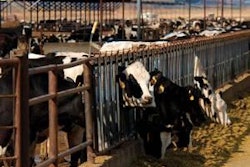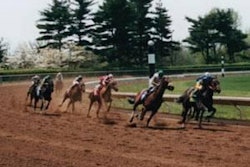
Take a look at the website of the regional council of Brittany (www.region-bretagne.fr) and you will find a series of maps showing the name and location of every mill in this area of northern France as well as the animal nutrition companies regionally that have ISO or GMP+ certification. (See Figure 1.)
It is worth examining not only the maps themselves, but also related commentaries. One such text about feed mills that was written in 2004 noted how Brittany/Bretagne in 2003 had produced some 9.5 million metric tonnes of animal feeds, which signified the region had been home to 44 percent of total French feed production for that particular year. The percentage was more revealing than the tonnage. France's feed statistics show that only 10 years earlier, Brittany's share of the national volume had been close to 50 percent.
An obvious person to ask about reasons for the change is Adolphe Thomas, president of the all-France private sector feed association Syndicat National des Industriels de la Nutrition Animale (SNIA). For the record, his new counterpart at the separate Syncopac association representing the co-operative's side of the business is Jean-Luc Cade, a 46-year-old pig producer from Brittany who is director of La Paysanne d'Erquy in Brittany's regional capital of Rennes. Mr. Cade's election coincided with an agreement by Syncopac to join a Coop de France federation of all French co-operatives.
Mr. Thomas is also from Brittany, as underlined by his long-time presidency of regional feed body Association des Fabricants d'Aliments du Bétail de Bretagne (AFAB). Today the general manager of the premixing arm of French animal nutrition group Evialis, he was previously in charge of the Questembert site near Vannes in Brittany which had been the main feed-producing centre for the group then known as Guyomarc'h. The site now is operated by the Nutrea joint venture between Evialis and Breton farm co-operative Unicopa and produces around 300,000 tons of feed per year.
Regional feed production
A boom in Brittany's feeds business coincided with his time at Questembert. When visited by Feed International in 1994, for example, regional feed production had reached 9 million tons. By 1998 this had become about 9.75 million tons and volumes seemed on their way to hitting an all-time high at the end of the decade. But events since then have told a different story. The total of 8.983 million tons recorded by SNIA-Syncopac data for the region in 2005 indicated a 5 percent reduction and showed Brittany to have suffered a feed output reduction for the eighth year in succession. In fact the annual reductions seem to be growing. In 2003 the decrease had been 1.8 percent, swollen to 2.6 percent in 2004. The volume produced in 2005 by the feed mills of Brittany meant that they were responsible for less than 41 percent of all feeds made in France last year.
Measure it another way, say some French observers. In the 10 years since 1996, Brittany's feed production has fallen back by almost 800,000 tons.
The situation today is illustrated by a frequently quoted estimate that the amount of feed manufacturing capacity in Brittany exceeds the current requirement by a figure that stands somewhere between 600,000 to 1 million tons per year often said to be equivalent to the production from two big mills. The implied suggestion obviously is that closing a site would remove most of the overcapacity to the benefit of the operators who remained, but no one has blinked yet and announced a mill closure. Indeed, there is even optimistic talk of the growing demand for complete feeds and supplements for cows, in a region that has been associated traditionally with feeding poultry and pigs.
Poultry market share
The connection to poultry feeds is mentioned by many people in their own analysis of the Breton feed scenario. They point to the severe competition from lower-cost countries encountered by the French poultry meat exporters as well as to the market downturn that has accompanied avian influenza internationally. It is something that Adolphe Thomas himself raises in our conversation with him.
"You have to remember that although animal production in Brittany is now diversified, the classic mixture of poultry and pigs is still basically at the heart," he comments. "The poultry sector has been difficult, there can be no doubt about that. Losing market share to other exporters has definitely reduced the quantity of poultry meat produced in Brittany as in other parts of France. Inevitably, the amount of poultry feed made by mills in the region has also decreased as a consequence."
Mr. Thomas notes that France's present feed output of about 22 million tons contrasts with a peak of 23 million tons in 2001. Since that time, the country has lost 2 to 2.5 percent of volume per year. Brittany's feed manufacturers have been losing more than that in other parts of France, he declares. The reasons start with the fact that their region is still the largest nationally so they have had more to lose. Also, other parts of the country have enjoyed the advantage that a larger part of their feed output is for ruminants, a sector (especially dairy cows) that has been increasing at the same time.
"About 10 years ago, Brittany's market share was close to 50 percent. Now it is less than 45 percent. But I do not personally see a very hard decline in the coming years, for France or for this region. Its infrastructure is very efficient. In my view, in the foreseeable future the share of the French feed market held by Brittany will be up to 40 percent."
Addressing the SNIA general assembly in May 2006 he had said, "I would really like to tell you that the erosion of feed fabrication in France over the last four years had been reversed and growth had started again. To be realistic, though, the volumes still decrease and avian influenza has arrived to remind us that the crises persist.
Figure 2: French feed production (metric tonnes) since 1964
Strong future predicted
"Nevertheless," he declared, "we have good reason to believe in the future of animal production in France and therefore of our own sector that manufactures the feeds. There is a strong future for those in animal nutrition who adapt to the evolutions of society and to the needs of livestock producers."
He expands on this now in his interview with Feed International. "What I wanted to say was that we should not be pessimistic," he remarks. "Of course it is true to observe that the volume of feeds from French mills has declined since 2001 and we can probably also agree that a decrease of around 2 percent per year may be seen for the next few years.
"However, it is not right at all to think that feed production in France could drop by as much as 30 percent as some people have suggested. That is quite wrong. I expect the annual volume will stabilize in 5 to 6 years as the livestock producers of this country adapt more to the demands of the consumers of meat, milk and eggs in terms of their quality, their diversity, their safety and their cost.
"The immediate outlook is quite good regarding feeds for ruminants, even if the production of pig feeds is down and avian influenza has affected the poultry business. In the medium to longer term it is a question of our ability to compete with other countries. Therefore, as I told the general assembly of our association earlier this year, the politic aspect cannot be ignored.
"Politicians have a great responsibility for the future of livestock production in Europe. The development of the global trade in foods is a fact of life. More and more food items are being traded from one part of the world to another. But we should not accept the importation into Europe of meat products that have not been produced according to the same rules and standards that govern our own production. Our costs will be higher than theirs because of those rules and therefore we cannot compete. The politicians of Europe must realize that an open door to all imports is not the way forward. They need to be asking, how have these meat products been produced? When they start doing that then I believe the outlook for well-managed feed businesses in France and in the other European countries will be quite good."


.jpg?auto=format%2Ccompress&fit=crop&h=167&q=70&w=250)














